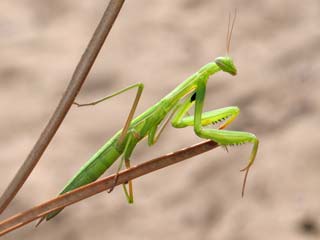| Latin Name: Mantis religiosa Family: Mantidae Order: Mantodea Group: Insects |
Mantis religiosa is a large insect, measuring 40 – 80 mm in length, with two developed forewings and two hindwings. The hindwings resemble a sheet of glass, with a light green or pale brown color, and a small black dot often accompanied by a lighter brown spot in the center at the front edge. The thorax is elongated, and the forelegs have a distinctive shape resembling a sword, with serrated edges used for capturing prey and fighting off enemies. Females are typically larger than males (Females: 48 – 76 mm; Males: 40 – 61 mm). Their coloration varies based on their habitat, commonly appearing in shades of green, brown, or yellow, especially when stalking prey.
Biology:
 |
(Image: curieux-de-nature) |
They feed on various insects that are present in their vicinity while hunting, but they selectively feed on specific prey during their larval stage, primarily focusing on aphids. Mantis religiosa can even exhibit cannibalistic behavior, especially females consuming males during or after mating. Egg-laying occurs from early summer to late autumn.
Females lay eggs shortly after mating, producing around 100 to 300 eggs that are arranged in a consistent manner within an egg case. Eggs laid during summer or early autumn usually hatch within a short period (approximately one month). However, eggs deposited late in the autumn survive through the winter, hatching in spring, with the larvae growing rapidly and maturing after four molts.
Habitat and Ecology:
The body color typically provides protective camouflage in line with the colors of surrounding plants and habitats, with three basic colors as described earlier. They are commonly found on larger trees and shrubs rather than on grass-like plants.
Distribution:
– Vietnam: Found throughout Vietnam; they have been documented in Lang Son, Quang Ninh, Ninh Binh, and Quang Binh. This species is the only representative of the order Mantodea included in the Red Book of Vietnam.
– Worldwide: This species has a broad distribution in both temperate and tropical regions across continents, including Europe, Asia, Africa, and even North America and Australia.
Usage Value:
This insect species is more beneficial than harmful as it preys on many harmful insects, particularly various aphid species (Aphididae). They also contribute to the beauty of nature. However, they may occasionally consume honeybees and other beneficial insects.
Status:
The population of Mantis religiosa is currently quite low and rare due to environmental factors, predators, cannibalism, and collection by children in Vietnam for play. Many countries classify them as rare insects.

(Image: carnet)

















































